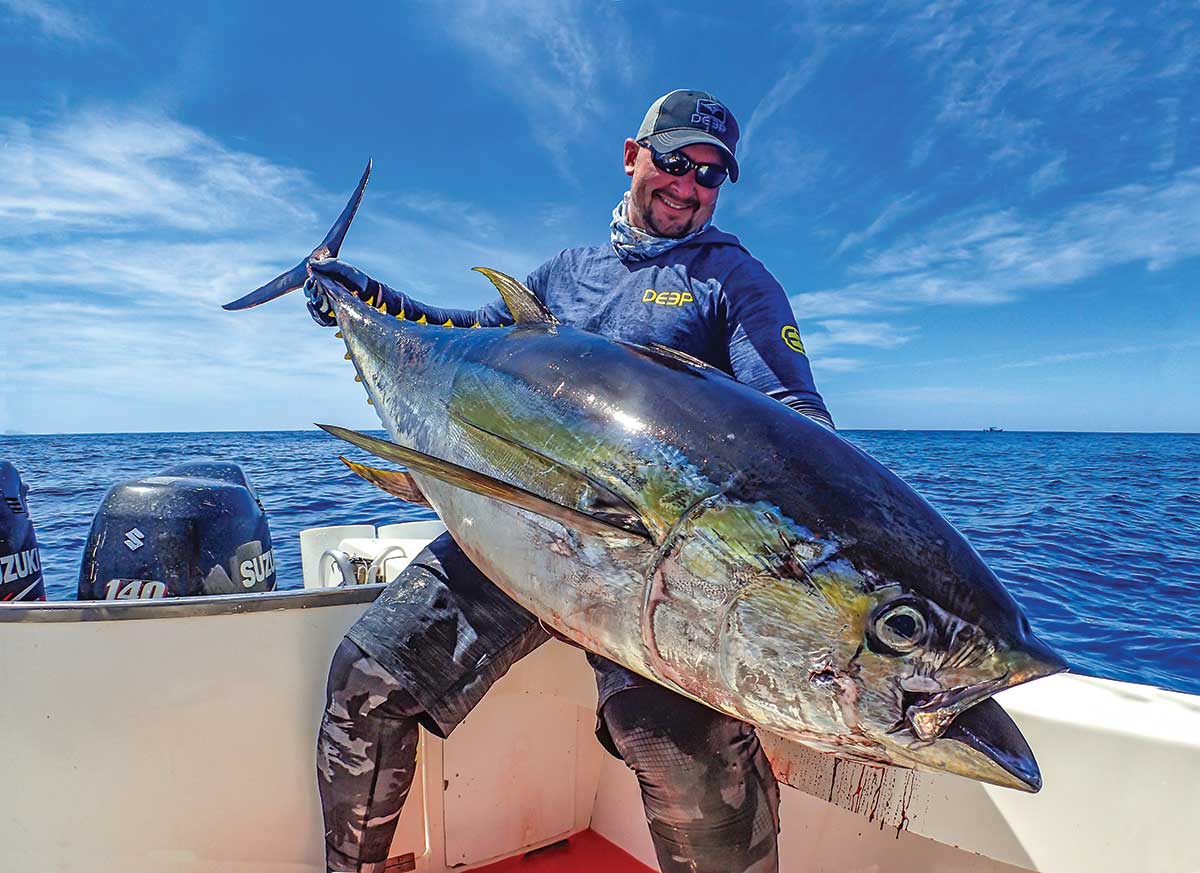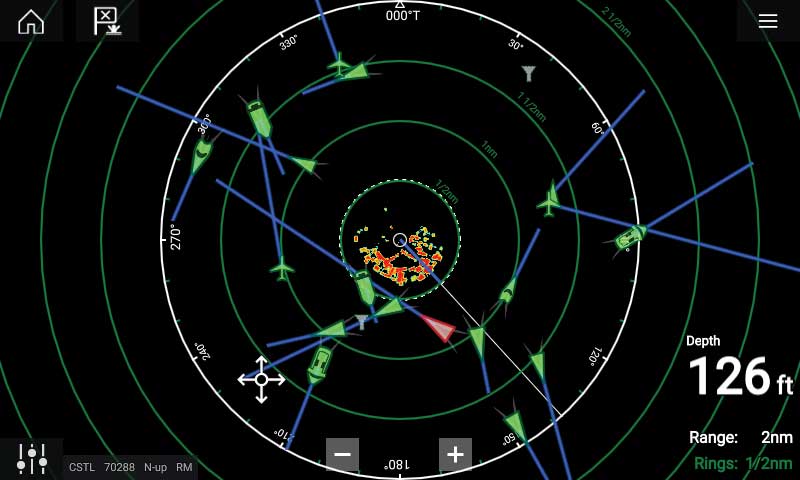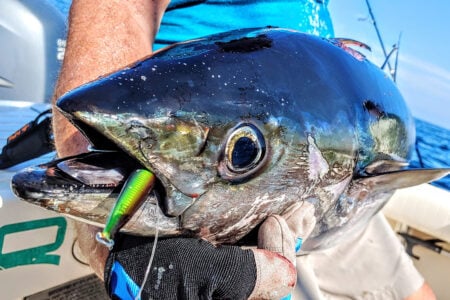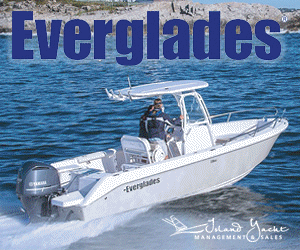
Getting the crew involved in decision making and planning will allow everyone to enjoy and appreciate the planning that goes into a successful trip.
The Cheshire Cat from Alice in Wonderland stated, “If you don’t know where you are going, any road will take you there.” Having a game plan is an important way to ensure success in any endeavor. What separates a true “master of planning” is the ability to forecast changing situations and having multiple game plans at the ready. For fishing, not only is it important to have a mental strategy, but pre planning also entails equipment, bait, crew, ice, fuel, and other variables. There are also elements out of your control that will change throughout your trip; weather, waves, currents, tide, feeding fish etc. It is important to have an initial game plan and know when to stick with it and when to call an audible.
An hour after leaving the dock for an overnight canyon trip my crew spotted a 250-pound class mako on the surface menacing some bluefish. The guys turned and watched with excitement. My mate even ran into the salon and grabbed two rods rigged for sharks. I hovered my hand over the throttles twice, thinking about pulling back. Before doing so I quickly ran the scenarios through my head. How long would it take us to bait the shark? If we did hook up, how long of a fight would it be? What were the odds we would land it? What would I do with 250 pounds of shark for the next 30 hours?

Plan A was to head to Block Canyon for a confirmed yellowfin and bigeye bite. I didn’t want to run in the dark nor miss my daylight prospecting time at The Edge. I also wanted to save box space and ice for our intended target – tuna. If this fish presented herself at the canyon, different story. But we were still 60 to 70 miles shy. Deciding to stick to plan A, we made it to The Edge with approximately two hours of sun light left. Just enough time to find possible night spots to fish. After locating birds, whales and bait, a half an hour later we were chunking 70-pound yellowfin. We never even set out the trolling gear. We had a steady pick of nice yellows that was topped off with a 275-pound bigeye at 2 a.m. We had a few more yellows the next day and decided to pot hop for some gaffer mahi. The boxes were stuffed, and we headed for the barn early. Initially my crew was not happy that we didn’t at least try for the mako the day before, but now on the way back they all understood why, and were happy with the decision to stay with the original plan.
There are three main scenarios for finding fish offshore: Fish busting on surface, Fish feeding below surface, and no visible signs of fish. Each one has unique plans of attack with some overlap.
Busting on the Surface
There are two basic options given this scenario. Which you chose will depend on your strengths, weaknesses, and the crew you have on board. Also, a factor is what gear and technique you are better suited for. If you find fish busting, pick a side of the feeding school and try casting artificials. First try throwing plugs and poppers. Don’t all throw at once! Take turns throwing and working your offerings. This will keep crossed lines and tangles to a minimum. You also must decide how many fish you want hooked up at once. If two guys hook up it may be wise to concentrate on landing these fish before trying to hook up again. The species and size will factor into deciding how many fish you can control without risking losing them.

If whales are mixed into the frenzy be mindful of their position and take precautions, not only to steer clear but to keep your hooked fish away as well. If you approach the school by pushing up current to it, when you hook up you will have an easier time pulling the hooked fish clear of the other feeding fish and whales. This is important so as not to chafe off. If you hook one fish power the boat in a manner to steer the hooked fish away from the school. You can throw other plugs back towards the school or jig to achieve a multiple hook up. If you have live bait, use it. There is no need to chunk as the fish are feeding on the surface. Live line an offering back to them.

The other option for busting fish is trolling. When selecting lures keep in mind you don’t need to raise the fish; they’re already up! Select lures and daisy chains that best mimic the bait present. Use less offerings and put them further back. Spreader bars, teasers and dredges are not necessary and limit your maneuverability so keep them out of the spread. Ballyhoo are a great option, naked or with skirted heads. The furthest from the boat should be the heaviest weighted heads from 5 to 8-plus ounces. Do not troll through the middle of the school. Surrounding boats will heckle you on the radio for making a “googan mistake.” Not only will you push the fish down, if you hook up in the middle there is greater chance of chaffing off on another fish. Instead work the perimeter or the corners. As you turn around the school you can easily slide the longer trolled baits further into the school. This is a great time to bump troll too. When the heavier ballyhoos make their way into the school take the boat out of gear and let them sink. Initially they will mimic a wounded baitfish as they sink. Then bump the boat into gear and bring it back to trolling speed. This will allow the ballyhoo to run up from depths acting like a fleeing baitfish.
Feeding Below the Surface
This scenario unfolds by visually spotting slicks, birds and an occasional busting fish. If using the jig and popping gear switch over to diving plugs, Ron Z lead heads, jigs, or any slanted nose or lipped lure that will dive. You can throw wide mouth poppers that create a large spray pattern and commotion, as they will also attract sub surface fish to come up. Use your fish finder to mark the edges and as before, work the outsides. Pay attention to the size of the marks on your screen. If larger fish are hanging low drop jigs down and target them specifically. Using metered or marked line on your jigging set up will help get you into the exact feeding zone.

If you are going to troll, stay on the sides and troll around it using weighted ballyhoo positioned in the long and center riggers. The middle range lures should now be spreader bars and wide trackers. In this scenario you are trying to raise the school. Closest to the boat deploy diving plugs, heavy weighted daisy chains, planers or anything you have that will get your baits down. Bump trolling will work great here as well. If they won’t come up for you try adding splash bars and or dredges.
A third option is to start chunking. Position the boat to have your drift take the boat across the corner of the school and chunk heavy. Have two chunk lines out (if you have live bait even better). Work a jig as well. If you don’t hook up motor away from the school and arc back to your starting point. If you are jigging a Ron Z keep it in the water as you slowly head back. These types of lures troll well, and you will increase your odds of hooking up.
No Visible Signs
This is also referred to as prospecting or mowing the lawn. All hands-on deck. Everyone should be looking for signs of life. Good binoculars are a must. The captain should be using his electronics; fish finder, radar, VHF, and AIS. If you cannot locate any obvious potential hotspots, look for draggers. Use your radar and AIS to locate them. Like a dinner bell, the noises they emit entice and attract all sorts of pelagic species. When working in and around a dragger’s territory show some respect. These captains are making their lively hood by working an area in a pattern. Discover the pattern and work with them while staying out of their way. A prospecting trolling pattern should be simple and maneuverable. When looking for fish troll faster to cover more ground. When you spot a fishy area that may have potential you can slow down and add lures to your initial spread.
You not only need a game plan to attack each scenario, you also need an arsenal of gear. With the increasing popularity of center consoles, dealing with limited space is a major consideration. You must find gear that’s suited for multiple tasks. A spinning reel with a mid-range ratio may not be optimal for specific tasks but may offer you greater versatility. The same goes for rod lengths. A shorter rod may not cast as far but will allow you the option to jig with it. When purchasing gear stay away from specialty set ups designed for one specific task or style. Find gear that can be utilized for multiple applications.
On the grounds, take what’s given to you, search for what’s not. Call audibles and change techniques as needed. Get the crew involved in decision making and planning. This will take some of the stress off the captain and will allow everyone to enjoy and appreciate the planning that goes into a successful trip.



